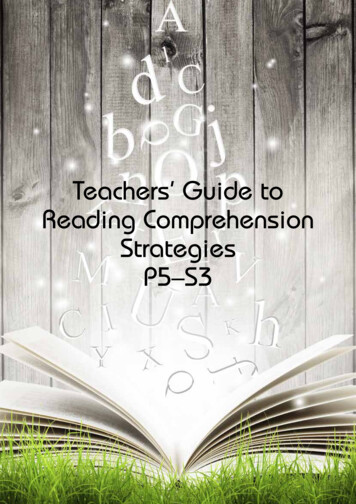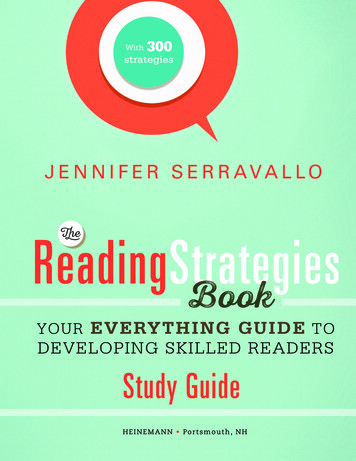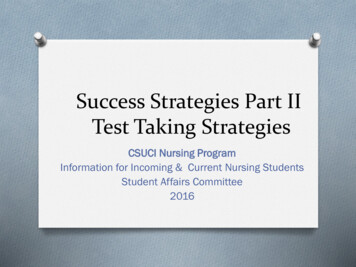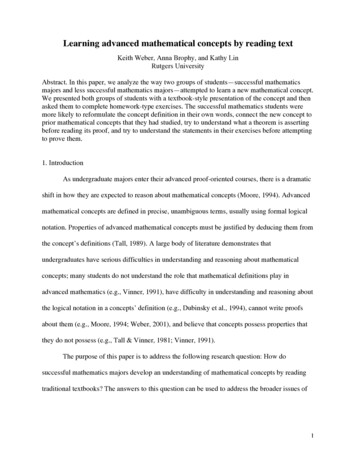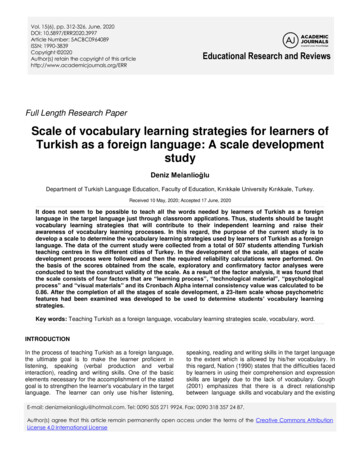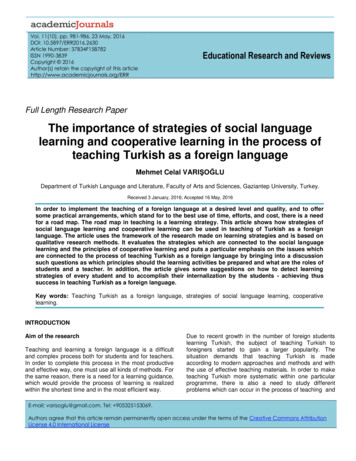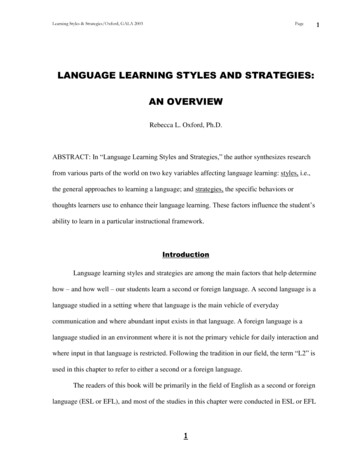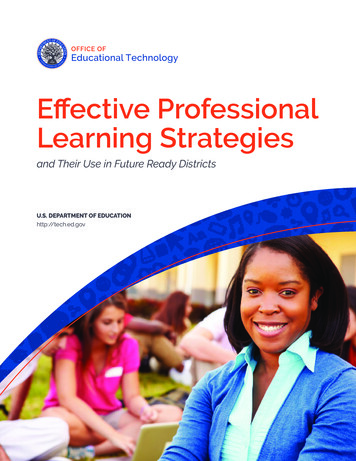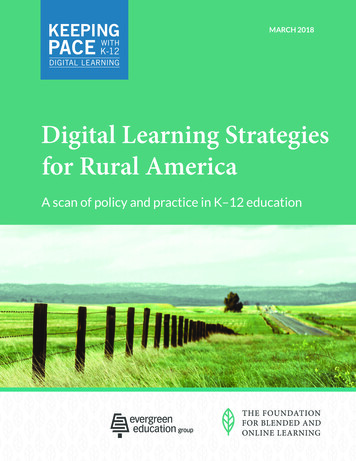
Transcription
Reading to Learning – Strategies to BuildReading Skills for the GED Test12/11/2018Reading to Learning –Strategies to Build ReadingSkills for the GED TestA Workshop from GED Testing ServiceDecember 11, 20182Debi FaucetteGED Testing ServiceSusan PittmanPD Consultant33 Copyright GED Testing Service LLC. All rightsreserved.1
Reading to Learning – Strategies to BuildReading Skills for the GED Test12/11/2018Session Objectives Discuss issues that students have with reading Reading Rate Vocabulary Basic Comprehension Analysis Review strategies and activities to help students improvetheir reading skills Share ideas and resources44So How Can You “Build” a Better Readerand GED Test Passer?55 Copyright GED Testing Service LLC. All rightsreserved.2
Reading to Learning – Strategies to BuildReading Skills for the GED Test12/11/2018Some Advice Spend time observingstudents as they read Build reading rate Teach students how to useinference skills Provide opportunities for morereading practice in differentcontent areas Build vocabulary Teach before, during, and Show them the joy of readingafter reading skills66Building a Better ReaderINSTRUCTIONModelSkills andStrategiesCONFIDENCEPRACTICE SKILL77 Copyright GED Testing Service LLC. All rightsreserved.3
Reading to Learning – Strategies to BuildReading Skills for the GED Test12/11/2018Before Diving In A short reminder about the importance of reading skills Reading Is fundamental Is essential for developing or enhancing higher order thinkingskills (e.g. critical thinking, problem solving, and reasoning) Is at the heart of all content—without reading skills, contentcannot be accessed or learned Provides the necessary framework that enables learning88Proficient Readers (and Writers) Can Read complex text Identify text structure Look for key words and phrases Unpack the prompt Develop a claim or argument Find the evidence that supports that claim or argument Analyze and evaluate the evidence Explain how the evidence is connected to the claim orargumentThis holds true across all content areas99 Copyright GED Testing Service LLC. All rightsreserved.4
Reading to Learning – Strategies to BuildReading Skills for the GED Test12/11/2018Overview of RLA Test Content - Integrated reading and writing Close reading Clear writing Editing and understanding the use of standard written English incontext Source texts – 75% nonfiction; 25% fiction Passage length – 400-900 words Range of text complexity, including texts at the collegeand career-ready level Technology-enhanced items and extended response1010AdviceSpend TimeObserving.1111 Copyright GED Testing Service LLC. All rightsreserved.5
Reading to Learning – Strategies to BuildReading Skills for the GED Test12/11/2018The Complexity of ReadingReading is like driving a car,except Readers must Build the car (develop themechanical systems foridentifying words) Maintain the car (fuel it withprint, fix up problems along theway and make sure it runssmoothly) And, most importantly, drivethe car (which requires us tobe motivated, strategic andmindful of the route we’retaking)Marilyn Adams, Ph.D., Brown University1212Check to See if Students are Rereading the text repeatedly Reading less text than theirpeers Using their fingers to point atwords as they read Sub-vocalize words as they read Unable to answer basicquestions about what they read1313 Copyright GED Testing Service LLC. All rightsreserved.6
Reading to Learning – Strategies to BuildReading Skills for the GED Test12/11/2018AdviceIncreaseReading Rate.1414Do You Know YourReading Rate?15 Copyright GED Testing Service LLC. All rightsreserved.7
Reading to Learning – Strategies to BuildReading Skills for the GED Test12/11/2018Reading Rate and FluencyWhat is the difference?Reading fluency – the speed and ease with which one readsconnected text aloud with accuracy, speed, and appropriatephrasingReading rate – how quickly you read with understanding16Reading Rate ProblemsAccurate word pronunciation but slow readingresults in: Reading less text than peers and having less time toremember, review, or comprehend the text Expending more cognitive energy trying to identifyindividual words Increasing inability to retain text in memory Failing to integrate various parts of the text17 Copyright GED Testing Service LLC. All rightsreserved.8
Reading to Learning – Strategies to BuildReading Skills for the GED Test12/11/2018How Fast Should My Students Read?18Doesn’t Reading Rate Depend on the Text?Type of MaterialsPurpose for ReadingDesired Level ofComprehension100%Appropriate Rate ofReadingUnder 200 wpmPoetry, legal document,argumentative writingAnalyze, criticize,evaluateTextbooks, researchdocumentsHigh comprehensionrecall for exams, writingresearch reports,following directions80%200-300 wpmNovels, paperbacks,newspapers, magazinesEntertainment,enjoyment, generalinformation60-80%300-500 wpmReference materials, catalogs,magazines, non-fictionOverview of material,locating specific facts,reviewing of previouslyread materialBelow 60% 500 ntly-understanding-and-speedOpen Sources for English Language Teaching Portal19 Copyright GED Testing Service LLC. All rightsreserved.9
Reading to Learning – Strategies to BuildReading Skills for the GED Test12/11/2018Determining Reading RateA student’s reading rate may be calculated by dividing thenumber of words read correctly by the total amount ofreading time.Example: Count out 100 words in a passage and then timethe student as he or she reads the passage.If a student reads 92 words correctly in 1.5 minutes, thestudent has a reading rate of 61 words per minute (wpm). Astandard word is six letter spaces including punctuationand spacing.20Building Reading Rate - WARF21 Copyright GED Testing Service LLC. All rightsreserved.10
Reading to Learning – Strategies to BuildReading Skills for the GED Test12/11/2018Timed Reading ResourcesJamestown Education Print only GLE 4-13 7 books in series22Strategies for Reading Rate Speed drills/rapid wordrecognition chart Repeated readings Taped books/tape-assistedreading Timed readings Oral reading Chunking23 Copyright GED Testing Service LLC. All rightsreserved.11
Reading to Learning – Strategies to BuildReading Skills for the GED Test12/11/2018AdviceBuildVocabulary.2424Building VocabularyVocabulary falls into fourcategories:1. Listening: the words weunderstand when we hearthem.2. Speaking: the words we usewhen talking.3. Reading: the words weunderstand when we read4. Writing: the words we usewhen writing25 Copyright GED Testing Service LLC. All rightsreserved.12
Reading to Learning – Strategies to BuildReading Skills for the GED Test12/11/2018Word Meaning - Vocabulary1.2.3.4.I never saw or heard the word before.I’ve heard it, but I don’t know what it means.I recognize it in context – it has something to do with I know it and I can tell you what it means. (In otherwords, I can use the word.)26Word Meaning - VocabularyHow many words does a typical nativespeaker know?a. 5,000b. 10,000c. 20,000d. 40,00027 Copyright GED Testing Service LLC. All rightsreserved.13
Reading to Learning – Strategies to BuildReading Skills for the GED Test12/11/2018Word Meaning - VocabularyWhat level of reading vocabulary is fun,challenging, or frustrating for students? 98% of words 95% of words 90% of wordsfunchallengingfrustrating28Tiered VocabularyTier 3Domain-specific academicvocabularyTier 2High-utility academic vocabularyfound in many content texts, crosscurricular termsTier 1Everyday words, familiar to most students primarilylearned through conversation29 Copyright GED Testing Service LLC. All rightsreserved.14
Reading to Learning – Strategies to BuildReading Skills for the GED Test12/11/2018Resource for the ClassroomSample Word Family - onreinterpretationsMost common formof the word family30Activities to Improve Vocabulary3131 Copyright GED Testing Service LLC. All rightsreserved.15
Reading to Learning – Strategies to BuildReading Skills for the GED Test12/11/2018Activities to Improve Vocabulary3232AdviceTeach Before,During, andAfter Reading.Strategies3333 Copyright GED Testing Service LLC. All rightsreserved.16
Reading to Learning – Strategies to BuildReading Skills for the GED Test12/11/2018Research to PracticeBeforeReadingDuringReadingAfterReadingLook at titleReview headings andsubheadingsAsk QuestionMake connectionsbased on what theyalready knowUse signal wordsUse context to identifyunfamiliar wordsReread and make notesSummarizeAsk clarifying questionsEvaluate what has beenreadDiscuss with the groupIdentify structureActivate priorknowledgeDetermine Purpose34Before Reading - TIPP It!3535 Copyright GED Testing Service LLC. All rightsreserved.17
Reading to Learning – Strategies to BuildReading Skills for the GED Test12/11/2018During Reading – Get the sionChange -Relationship (QAR)3838 Copyright GED Testing Service LLC. All rightsreserved.18
Reading to Learning – Strategies to BuildReading Skills for the GED Test12/11/2018AdviceBuild Inference.Skills3939Elkhart Community nsAnalysis of Text:Interpretation/ JudgmentImagination/Visualization40 Copyright GED Testing Service LLC. All rightsreserved.19
Reading to Learning – Strategies to BuildReading Skills for the GED Test12/11/2018“ To infer is to create newknowledge from existingknowledge.”41Start with What Students Know42 Copyright GED Testing Service LLC. All rightsreserved.20
Reading to Learning – Strategies to BuildReading Skills for the GED Test12/11/2018InferencesProficient readers can “readbetween the lines” and drawdeeper understanding andappreciation for what isbeing read.Types of ryOccupationor 3Strategies for Making Inferences Step 1: Gather clues and read “between thelines.” Step 2: Reach conclusions based onevidence and reasoning (Ask: Does itmake sense?)4444 Copyright GED Testing Service LLC. All rightsreserved.21
Reading to Learning – Strategies to BuildReading Skills for the GED Test12/11/2018Move from Simple to ComplexInference Finding the CluesFrom Simple rtparagraphsLonger, moreintricatepassages –fiction/mysteriesLonger, moreintricatepassages nonfiction4545What Can You Infer?46 Copyright GED Testing Service LLC. All rightsreserved.22
Reading to Learning – Strategies to BuildReading Skills for the GED Test12/11/2018What Can You Infer?47Teach Inference from Simple to ComplexInference Finding the CluesFrom Simple rtparagraphsLonger, moreintricatepassages –fiction/mysteriesLonger, moreintricatepassages –nonfiction4848 Copyright GED Testing Service LLC. All rightsreserved.23
Reading to Learning – Strategies to BuildReading Skills for the GED Test12/11/2018What can you infer?1. A character in a story has a diaper in her hand, spit-up on hershirt, and a bottle warming on the counter.2. A person has a briefcase, is on a plane, and is late for ameeting.3. A detective enter the house, which has been ransacked. Hesees blood on the floor, and it leads out the back door.4. Your friend walks past you without smiling. Her head ishanging down. She wipes a tear from her eye and looks at herphone.4949What can you infer?Screech! Karen stomped on the gas pedal the moment the lightturned green. She looked over her left shoulder and zigged past asemi-truck. She zoomed ahead and looked over her rightshoulder and then zagged past a motorbike. She glanced at theclock on the console and darted into the parking lot. Whippinginto a parking spot, she grabbed her suitcase and ran through thelot, up the escalator, and into the terminal. Her heavy suitcasewas bumping and bouncing the whole way. Just as she enteredthe terminal, she heard an announcement over the loudspeaker,"Final boarding call for flight 205 to JFK." Karen looked at herticket and then at the line to get through the security checkpoint,which wrapped around several turnstiles and slithered like alethargic snake. Karen sighed and then slowly walked to thecustomer service desk.5050 Copyright GED Testing Service LLC. All rightsreserved.24
Reading to Learning – Strategies to BuildReading Skills for the GED Test12/11/2018Example: It Says – I Say – And SoQuestionIt SaysI SayAnd SoRead the question.Find information from thetext to help answer eachquestion – paraphrase orquote answers from text.Consider what you knowabout the information.Put together theinformation from the textwith what you know, thenanswer the question.Why are forest fires on theincrease in the Black Hillsof South Dakota?For the last several years,precipitation amounts-snowfall has decreased.Less snowfall could meandry conditions throughoutthe Black HillsDry conditions resultingfrom a decrease inprecipitation may lead toconditions that mightmake fires more likely tooccur.5151Remember - Inference is Process-DrivenThe alchemy of inference: Using active reading skills (beyond the basics) Engaging with the text and/or information presented Questioning Thinking critically Making connectionsStudents need to be reminded that an inference isnot a wild guess!5252 Copyright GED Testing Service LLC. All rightsreserved.25
Reading to Learning – Strategies to BuildReading Skills for the GED Test12/11/2018AdviceProvideopportunities forpractice.5353Check Your Reading Speedhttp://www.freereadingtest.com/5454 Copyright GED Testing Service LLC. All rightsreserved.26
Reading to Learning – Strategies to BuildReading Skills for the GED Test12/11/2018Build Vocabularyhttps://www.vocabulary.com/5555Need Resources for Source Texts?Newsela https://newsela.com/56 Copyright GED Testing Service LLC. All rightsreserved.27
Reading to Learning – Strategies to BuildReading Skills for the GED Test12/11/2018ReadWorks.org5757Awesome Storieshttps://www.awesomestories.com/5858 Copyright GED Testing Service LLC. All rightsreserved.28
Reading to Learning – Strategies to BuildReading Skills for the GED Test12/11/2018Show Studentsthe Joy and Valueof Reading5959https://ged.com6060 Copyright GED Testing Service LLC. All rightsreserved.29
Reading to Learning – Strategies to BuildReading Skills for the GED Test12/11/2018Questions?Concerns?6161Thank you!Communicate with GED Testing Service communications@ged.com6262 Copyright GED Testing Service LLC. All rightsreserved.30
Dec 11, 2018 · Is at the heart of all content—without readi
